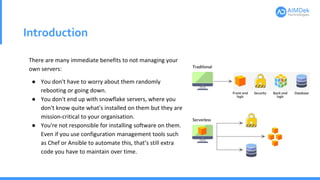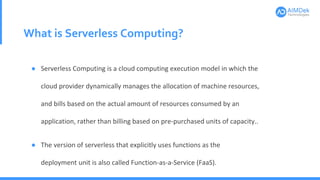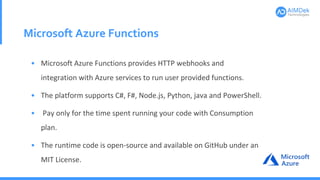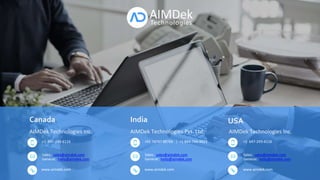What is Serverless Computing?
- 1. Serverless Computing By: Jainil Shah Mihir Mehta Viral Ghosh WWW.AIMDEK.COM
- 2. Agenda • Introduction • Serverless • Architecture • Characteristics • Commercial Platform • Benefits and Drawbacks • Use Cases and Workloads • API Composition • Demo
- 3. Introduction ● Serverless Computing (or simply serverless) is emerging as a new and compelling model for the deployment of cloud applications ● Conventionally, applications were written and run in servers which are allocated fixed resources. Soon problems arose with sudden spikes of traffic as demands increased and the servers were not able to handle the enormous amount requests. To address these problems, came Platform as a Service (PaaS) in which providers offered scaling but it has its drawbacks. ● It is a platform for rapidly deploying small pieces of cloud-native code
- 4. Introduction There are many immediate benefits to not managing your own servers: ● You don't have to worry about them randomly rebooting or going down. ● You don't end up with snowflake servers, where you don't know quite what's installed on them but they are mission-critical to your organisation. ● You're not responsible for installing software on them. Even if you use configuration management tools such as Chef or Ansible to automate this, that’s still extra code you have to maintain over time.
- 5. What is Serverless Computing? ● Serverless Computing is a cloud computing execution model in which the cloud provider dynamically manages the allocation of machine resources, and bills based on the actual amount of resources consumed by an application, rather than billing based on pre-purchased units of capacity.. ● The version of serverless that explicitly uses functions as the deployment unit is also called Function-as-a-Service (FaaS).
- 6. What is Serverless Computing? • The Infrastructure-as-a-Service (IaaS) model is where the developer has the most control over both the application code and operating infrastructure in the cloud • The developer is responsible for provisioning the hardware or virtual machines. • Can customize every aspect of how an application gets deployed and executed. • On the opposite extreme are the PaaS and SaaS models, where the developer is unaware of any infrastructure. • The developer has access to prepackaged components or full applications. The developer is allowed to host code here, though that code may be tightly coupled to the platform.
- 7. Serverless? • Serverless can be explained by varying level of developer control over the cloud infrastructure. Hardware/VM Deployment (IaaS) Custom Infrastructure Custom Application Code Shared Infrastructure Customer Application Code Shared Infrastructure Shared Service Code More Less Developer Control Full Stack Services (SaaS) Serverless
- 8. Architecture • Servers are still needed, but developers need not concern themselves • with managing those servers. • Decisions such as the number of servers and their capacity are taken care of by the serverless platform, with server capacity automatically provisioned as needed by the workload. • The core capability of a serverless platform is that of an event processing system. • The service must manage a set of user defined functions, take an • event sent over HTTP or received from an event source.
- 9. Architecture • The challenge is to implement such functionality while considering metrics such as cost, scalability, and fault tolerance. • The platform must quickly and efficiently start a function and process its input. • The platform also needs to queue events.
- 10. Serverless : Characteristics • Independent, server-side, logical functions : small, separate, units of logic that take input arguments, process them in some manner, then return the result. • Cost : Typically its Pay As You Go • Simple Deployment : Thanks to the small size of deployment artifacts, in general, deployments are simple and quick. Deployment artifacts are typically idiomatic of the chosen runtime e.g. NuGet packages, npm packages, JAR files • Ephemeral : designed to spin up quickly, do their work and then shut down again. • Programming languages : Serverless services support a wide variety of programming languages - Node, Python. • Stateless : FaaS are stateless, not storing states ,as containers running code will automatically destroy and created by platform.Horizontal Scaling becomes easy...
- 11. Serverless : Characteristics • Scalable by Default • Event Triggered :Although functions can be invoked directly, they are typically triggered by events from other cloud services, such as incoming HTTP requests, • Simple Deployment Model. • Small Deployable Units and More focus on Business Value. • Managed by third party . • No more “Works on my Machine”
- 12. Commercial platforms • Amazon’s AWS Lambda • Google’s Cloud Functions • Microsoft Azure Functions • IBM Cloud Functions • OpenLambda
- 13. Amazon’s AWS Lambda • Amazon’s AWS Lambda was the first serverless platform ,it is a compute service that lets you run code without provisioning or managing servers.” • AWS Lambda executes code only when needed and scales automatically, from a few requests per day to thousands per second. • Pay only for the compute time. • Can run code for virtually any type of application or backend service
- 14. Amazon’s AWS Lambda • Currently AWS Lambda supports Node.js, Java, C# , Go and Python and PowerShell • AWS Lambda automatically scales application by running code in response to each trigger. • With AWS Lambda,we are charged for every 100ms
- 15. Google’s Cloud Functions • Google Cloud Functions provides basic FaaS functionality to run serverless functions written in Node js , Go, Python and Java. • Automatically scales, highly available and fault tolerant. • No servers to provision, manage, or upgrade • Pay only while your code runs.
- 16. Microsoft Azure Functions • Microsoft Azure Functions provides HTTP webhooks and integration with Azure services to run user provided functions. • The platform supports C#, F#, Node.js, Python, java and PowerShell. • Pay only for the time spent running your code with Consumption plan. • The runtime code is open-source and available on GitHub under an MIT License.
- 17. IBM Cloud Functions (OpenWhisk ) • IBM OpenWhisk provides event-based serverless programming with the ability to chain serverless functions to create composite functions. • It supports Node.js, Java, Swift, Python, as well as arbitrary binaries embedded in a Docker container. • OpenWhisk is available on GitHub under an Apache open source license.
- 18. OpenLambda • OpenLambda is an open-source serverless computing platform. The source-code is available in GitHub under an Apache License. • The Lambda model allows developers to specify functions that run in response to various events. • OpenLambda will consist of a number of subsystems that will coordinate to run Lambda handlers:
- 19. Benefits • Compared to IaaS platforms, serverless architectures offer different tradeoffs in terms of control, cost, and flexibility. • The serverless paradigm has advantages for both consumers and providers. • From the consumer perspective, a cloud developer no longer needs to provision and manage servers, VMs, or containers as the basic computational building block for offering distributed services. • The stateless programming model gives the provider more control over the software stack, allowing them to, among other things, more transparently deliver security patches and optimize the platform.
- 20. Drawbacks • However, drawbacks to both consumers and providers. • For consumers, the FaaS model offered by the platform may be too constraining for some applications. • For the provider, there is now a need to manage issues such as the lifecycle of the user’s functions, scalability, and fault tolerance in an application-agnostic manner.
- 21. Current state of serverless platforms • There are many similarities between serverless platforms. • They share similar pricing, deployment,and programming models. • Current serverless platforms only make it easy to use the services in their own ecosystem. • Open source solutions may work well across multiple cloud platforms.
- 22. Use cases and workloads • Serverless computing has been utilized to support a wider range of applications. • HTTP REST APIs and web apps: traditional request and response workloads. • Mobile back ends: ability to build on the REST API backend workload above the BaaS APIs • Multimedia processing: The implementation of functions that execute a transformational process in response to a file upload
- 23. Event processing • One class of applications that are very much suitable for is event- based programming. • Image processing event handler function by AWS • The function is connected to a data store, that emits change events . • New image file is uploaded, an event is generated. • In the case of failure , the function can be executed again with no side effects.
- 24. API composition • Another class of applications involves the composition of a number of APIs • The application logic consists of data filtering and transformation. Mobile App Lat/long coordinates 3 day weather forecast in india def main(dict): zip = gis.geoToZip(dist.get(coord) forecast = weather.forecast(zip) afirstThreeDays = forecast(0:3) translated=language.translate(firstThreedays,“en”,“mal”) return(“forecast”:filter(translated))} Coordinate to ZIP code service Weather forecast Service Language translation Service
- 25. Conclusions • It is an evolution of the trend towards higher levels of abstractions in cloud programming models. Currently exemplified by the Function- as-a-Service (FaaS) . • There are some drawbacks also to Serverless computing like vendor lock-in and Vendor control. • The developers are dependent on vendors for debugging and monitoring tools. Debugging distributed systems is difficult and usually requires access to a significant amount of relevant metrics to identify the root cause.
- 27. www.aimdek.com AIMDek Technologies Pvt. Ltd. +91 78747 88766 | +1 844-744-4423 Sales: [email protected] General: [email protected] AIMDek Technologies Inc. +1 647-243-6116 Sales: [email protected] General: [email protected] AIMDek Technologies Inc. +1 647-243-6116 Sales: [email protected] General: [email protected] www.aimdek.com www.aimdek.com Canada India USA



























